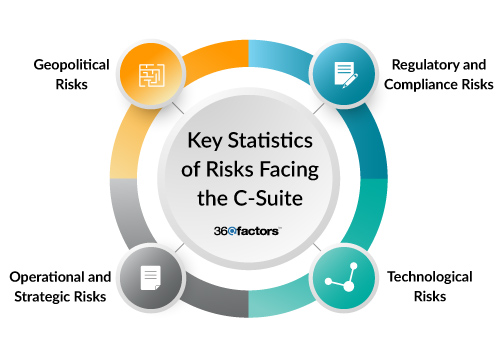Home/ Blog / Why C-Suite Leaders Must Prioritize Dynamic Risk Management to Drive Success in 2025
In 2025, the role of C-suite leaders will be increasingly focused on navigating complex and evolving risks. The expectations for C-suite leaders are growing with more emphasis on developing a holistic framework for dynamic risk management. In the rapidly changing financial industries, leaders must champion risk awareness and embed risk management into their decision-making processes. By doing so, they can explore more opportunities for organizational resilience, growth, and effective risk management.
Survey Reveals the Key Statistics of Risks Facing the C-Suite

A recent KPMG survey of C-suite leaders highlights the greater complexity of risk management, revealing key areas where business leaders expect challenges regarding risks in the years ahead. Here are the top risks that are expected to shape C-suite priorities in 2025:
Geopolitical Risks
Geopolitical risks were conventionally considered secondary; they are now becoming more impactful for dynamic risk management. In fact, 58% of CROs predict that this category will require closer oversight in the next three to five years. Geopolitical risks include international tensions, political instability, and trade disruptions. For example, the European Central Bank’s Financial Stability Review from May 2024 warned that heightened geopolitical tensions could lead to significant economic fragmentation. Similarly, corporate leaders must focus on the new realities of election outcomes and governance shifts, which are expected to influence business strategies globally.
Regulatory and Compliance Risks
Navigating regulatory challenges will be a key focus for C-suite leaders in dynamic risk management. Around 56% of CROs predict compliance and regulatory risks will escalate over the next few years. As businesses expand and digitize, regulations surrounding data privacy, financial reporting, and corporate governance are becoming more stringent. Currently, 47% of executives consider regulatory risks a top concern, emphasizing the urgent need for more robust compliance frameworks across industries.
Technological Risks
Technology is another key area in which C-suite leaders will be focused. The survey shows that 58% of CROs believe in technological risks, including cybersecurity risks, system outages, data privacy issues, cloud security concerns, and AI model bias. These risks will threaten operational continuity, data integrity, regulatory adherence, and customer trust. They will significantly impact growing organizations, so a dynamic risk management framework is needed. Currently, 42% of executives are already addressing these risks, but the figure is expected to rise as the digital landscape evolves.
Operational and Strategic Risks
Operational and strategic risks remain a major cause of concern, with 60% of CROs predicting that strategic risks will become even more pressing in the next three to five years. Disruptions to core business operations, whether due to supply chain issues, labor shortages, or shifts in consumer demand, are areas where leaders must pay more attention. Integrating dynamic risk management into long-term strategic planning is vital for organizations to deal with current and upcoming risks.
Proactive Solutions to Address Key Risks

Organizations must adopt a forward-thinking and comprehensive approach to managing diverse risks as the business landscape becomes more complex. Here are three essential solutions C-suite leaders should prioritize to strengthen their organizations:
Take a Holistic Approach to Enterprise Risk Management
In the current interconnected business environment, risks do not stay in isolation. C-suite leaders must look beyond individual teams and take an enterprise-wide risk view. This comprehensive dynamic risk management approach ensures that risks are detected, evaluated, and mitigated in all business areas as part of a unified strategy.
Enterprise Risk Management involves embedding risk awareness into every business layer, from front-line staff to senior leadership. By creating a culture where risk management is the accountability of every employee, C-suite leaders can promote more successful decision-making and resilience across the board. ERM is not just about reacting to immediate risks; it’s about aligning the risk management process with the company’s overall pursuit of objectives, ensuring the business is prepared for current and future risks. This integrated enterprise risk management process empowers companies to respond to evolving risks with agility and foresight.
Enable Leaders with Real-Time Data for Better Decision-Making
The conventional reporting methods are no longer effective in dealing with emerging risks. To stay ahead in the current competitive age, making informed decisions based on accurate time data is essential. It is a critical component of dynamic risk management. Cloud-based risk management solutions enable organizations to track risk exposure in real-time, offering insights into areas that need immediate attention.
Tracking emerging risks in real-time gives organizations a competitive advantage, as they can react much quicker compared to organizations relying on outdated information. It enables business leaders to implement proactive risk management solutions by analyzing current trends to forecast future risks.
Strengthen Organizational Resilience to Adapt and Thrive
Resilience is fundamental to any organization’s survival in dynamic business conditions. Building resilience means equipping your organization to withstand disruptions, recover from losses, and adapt quickly to changing conditions. A resilient organization can pivot in the face of hardship, whether it’s a supply chain disruption, a sudden regulatory change, or an unexpected technological failure. Organizations prioritizing resilience can maintain continuous operations, even under the most challenging circumstances, and quickly bounce back from disruptions.
To build resilience, businesses must integrate dynamic risk management into everyday operations. This involves adopting a data-driven approach, where key metrics for resilience, such as incident response times, recovery rates, and adaptability, are continuously measured. Also, by harnessing advanced computational models, companies can integrate several factors into the analysis, which helps decision-making in the current complex and fast-paced world.
Upgrade Your Organization’s Risk Management with a Powerful Cloud-Based Solution
Businesses will need agile, robust, and comprehensive risk management software solutions that can help them anticipate, evaluate, and respond to emerging risks in 2025. One of the most effective ways to ensure that your organization is equipped to manage the complications of modern risk is by leveraging advanced, cloud-based, dynamic risk management solutions like Predict360 ERM Software.
Predict360 Risk Management Software offers a comprehensive approach to managing risks across the enterprise. It provides C-suite executives and risk managers with complete visibility of business operations, strategic risks, and regulatory issues on a single dashboard. The software integrates real-time data from multiple sources within the organization, ensuring that any new risk is instantly reflected in risk metrics and made visible to all authorized stakeholders.
It facilitates identifying and evaluating potential risks across various business functions and processes. One of the standout features of Predict360 is its real-time monitoring capability, which keeps management informed of the current risk landscape. By systematically monitoring internal and external risks, organizations can avoid possible disruptions and take proactive steps to mitigate them.
Request a Demo
Complete the form below and our business team will be in touch to schedule a product demo.
By clicking ‘SUBMIT’ you agree to our Privacy Policy.



